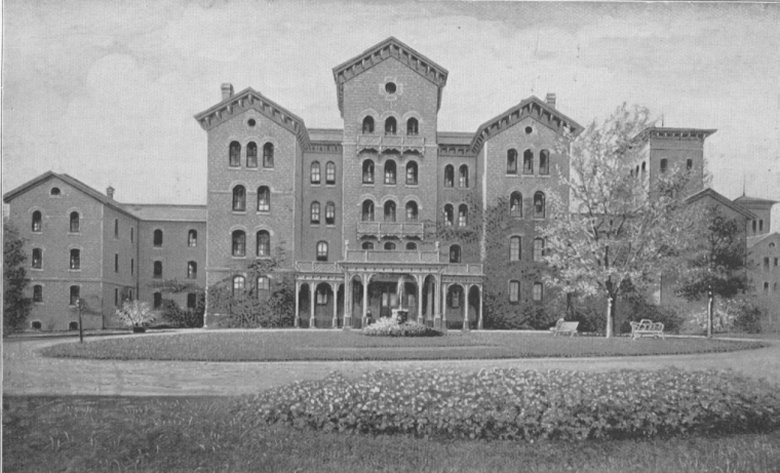

Main Building
Spring Grove Hospital
1853-1964
Click on the Front Door to Enter. This photo tour shows the Main Building of Maryland Hospital for the Insane at
Spring Grove near Catonsville, MD, as it existed at the turn of the
20th-century. With one possible exception, all images are from the Main Building.
Most of the photographs included on the tour are believed to have been taken
between 1880 and 1910, although a few are more recent. Several images are
linked to their exact original locations in the building (e.g., the
superintendent's office, the lobby, and kitchen), while others may or may not be
exact matches. The "Amusement Hall," shown as a thumbnail above the floor
plan, was located on the second floor of the central section, above the kitchen. The Boiler
House (shown above the floor plan in the tour) was built at
the same time as the Main Building, and is still in existence.
The "Old Main" (shown above as it appeared in 1896) was the original
building
at the Spring Grove site of the Maryland Hospital for the Insane. Although construction was started in 1853, the
Main Building was not substantially completed and ready for full occupancy until 1872.
Work on the building stopped in 1862 and was not resumed until 1868. However, enough of the north wing (above, right) was completed by
the start of the Civil War (1861) to allow for
that part of the building to serve as
a military hospital during the War. The first psychiatric patients were
transferred from the Baltimore City location of the Maryland Hospital to the newly
completed facility at Spring Grove on October 7, 1872.
The Main Building's original capacity was 325 patients, and its cost, including landscaping and several associated outbuildings, was approximately $760,000. From the beginning, the Main Building had running water, flush toilets, gas lighting and forced air central heating. Hot water for a heat exchanger was piped to the building's basement from a nearby Boiler House. Electric lights and a telephone system were added in the 1890s. (Combination gas and electric chandeliers may be seen in some pictures from the turn of the 19th Century.) The Main Building was designed in accordance with the Kirkbride Plan, which called for a monumental center section, and two large wings -- one for male patients and one for females patients. The north wing was called the "Male Department," and the south wing was called the "Female Department." The individual units on each wing were arranged in a progressive set-back configuration, a system that allowed for the classification of patients by level of functioning, and kept the various levels of care ("Violent Female," "General Female," "Convalescent Female," "Violent Male," "General Male" and "Convalescent Male" ) fairly separate from each other.
Although there were several major expansions of the building in later years, originally it had 18 patient care units or "wards" (later called "Halls") -- three floors, with three units en echelon on each floor of each wing. The central section of the building, referred to in early records as the "Centre Building," included administrative offices and other central elements such as the kitchen and the Amusement Hall.
Sadly,
the "Old Main" was demolished in 1964, and all that's left of the
original complex is the Boiler House - the northern section of today's laundry
building. The Main Building stood on the lot
across the street from the current Spring Grove Administration Building, and
extended north to beyond where the Jamison Building stands today. The circular
lawn seen in front of the Main Building in the above picture exists today as the
"island" at the center of the traffic circle near today's
Administration Building on Ash Street.